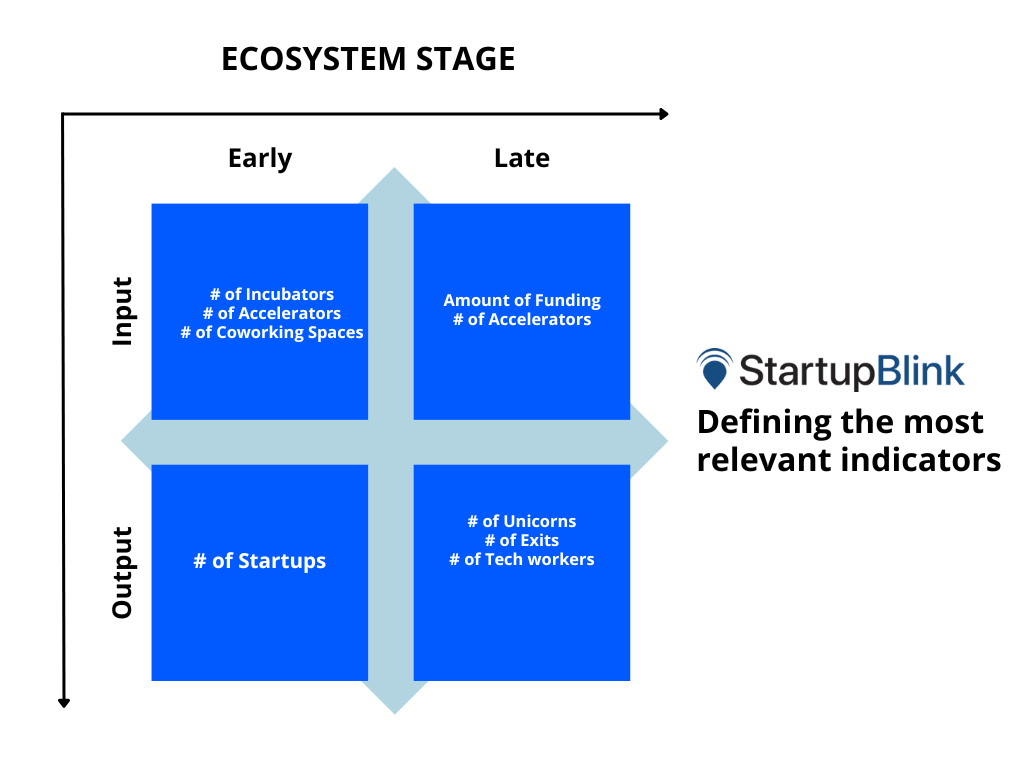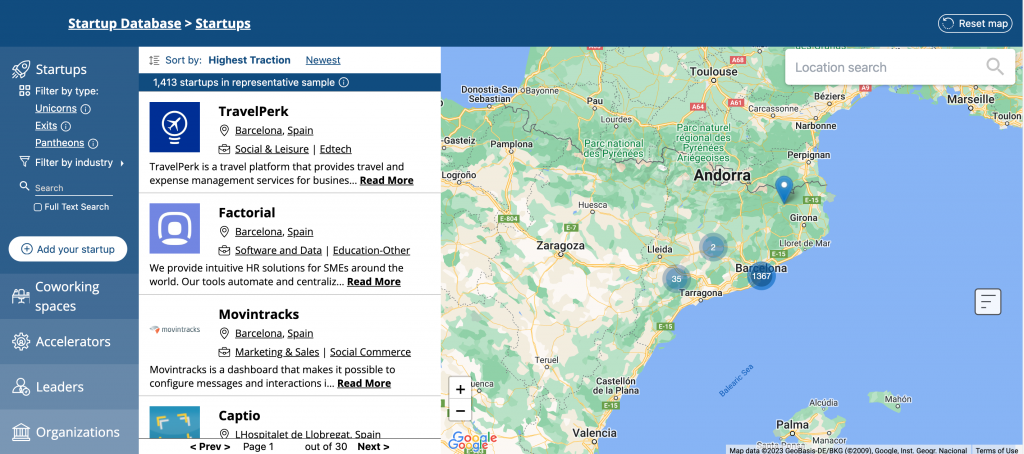A strong startup ecosystem has the potential to generate remarkable success stories, from unicorns to massive corporations. These success stories draw significant investor interest and bolstering foreign direct investment. At the core of building a strong startup ecosystem lies Startup Ecosystem Analysis – the key phrase that unlocks insights about your ecosystem.
How StartupBlink Analyzes Startup Ecosystems?
StartupBlink presents its Health Check Analysis as one module of our Ecosystem Development Services. The Health Check Analysis is a comprehensive evaluation that sheds light on the factors shaping an ecosystem’s rankings.
1. Subscore Analysis
This component lays bare the different subscores and their significance in determining the overall rankings. By examining each subscore in detail, we gain valuable insights into how specific parameters contribute to the ecosystem’s overall standing.
2. Health Check Analysis
At the heart of our Health Check Analysis is a close examination of an ecosystem’s “Health Check” by looking at specific factors one by one. We carefully study how the ecosystem is ranked for each of these factors and see how its overall ranking would change if we didn’t consider these specific factors in our evaluation. This detailed investigation helps us pinpoint the essential areas that have a big impact on an ecosystem’s success.
3. Benchmarking Against Other Ecosystems
The third component of our evaluation is the Peer Analysis, where we compare an ecosystem’s performance in each parameter against its peer ecosystems. By benchmarking against similar ecosystems, we gain valuable perspectives on its strengths, weaknesses, and opportunities for growth.
4. Ecosystem Simulations: Forecasting Ranking Changes
Through ecosystem simulations, we project potential changes in an ecosystem’s ranking if it were to create special entities or attract strategic branches from tech corporations. This approach offers strategic insights for ecosystem stakeholders.
5. Recommendations: High-Level Insights for Growth
Our analysis concludes with the Recommendation section, where we present high-level recommendations based on the findings. These insights serve as a roadmap for ecosystem improvement, guiding stakeholders towards impactful decisions.
For those seeking a more comprehensive evaluation, our team is equipped to perform a full ecosystem diagnosis and roadmap report, ensuring a well-rounded strategy for future growth.
How to Analyze Your Startup Ecosystem?
1. Perform Hard & Soft Monitoring
Hard Monitoring
Hard monitoring involves gathering and measuring relevant indicators to gain insights into its health and progress. Key metrics include the number of startups, funding amounts, and other quantitative data. Additionally, it’s essential to identify comparable ecosystems and make comparisons to understand your ecosystem’s standing.
Our ecosystem partners benefit from detailed analysis reports, enabling them to benchmark against peer ecosystems on over 40 parameters.
Through our experience with policy advising, we realize that keeping track of ecosystem-related laws and regulations is equally important to understanding the impact on the ecosystem’s growth and development.
Soft Monitoring
Incorporating soft monitoring strategies is equally crucial for a detailed analysis. This involves maintaining open channels of communication with a diverse range of stakeholders through networking events, meetups, and constant update conversations. It’s also essential to monitor startup ecosystem news through press outlets, social media, and dedicated newsletters, with encouragement for dedicated press or private sector stakeholders to assume responsibility for spreading notable updates.
2. Define the Most Relevant Indicators

To effectively analyze your startup ecosystem, it is crucial to identify the most relevant indicators or key performance indicators (KPIs) for ecosystem monitoring. These indicators can be categorized based on different stages of the startup process and their corresponding outputs.
For example, an early-stage startup ecosystem can expect to have more startups, as a result of increasing the number of incubators, accelerators and coworking spaces. Conversely, a late-stage startup ecosystem should expect to observe an increase in the number of unicorns, exits and tech workers as a result of more funding and increased number of accelerators.
How to choose the right indicators for the Startup Ecosystem Analysis?
When conducting a Startup Ecosystem Analysis, it is crucial to select the right indicators that provide meaningful insights into the ecosystem’s strength and potential for growth. Focus on output indicators, which directly relate to the outcomes and results of the ecosystem. These include metrics like the number of startups, accelerators, incubators, exits, coworking spaces or for later stages amount of funding and unicorns. These indicators offer tangible evidence of the ecosystem’s performance.
Avoid relying on indicators with no clear correlation to the startup ecosystem’s success. For example, comparing the cost of living between different cities or considering population size and GDP might not provide relevant information about the ecosystem’s entrepreneurial potential or its ability to support startups. A large population can be both advantageous and challenging; while it signifies a larger market, it can also complicate implementation processes.
Likewise, government grants, while beneficial in some cases, should not be the sole determinant of a successful ecosystem. Grant funding may offer a temporary boost, but the long-term sustainability of startups depends on various other factors, such as market demand and access to skilled talent.
Integrating Entrepreneurs into the Monitoring Process

Entrepreneurs play a key role in contributing valuable insights to the ecosystem analysis. Fostering collaboration and involvement between entrepreneurs and analysts can lead to a clear understanding of the ecosystem. By encouraging active participation and feedback from entrepreneurs, ecosystem developers can create a more inclusive and accurate analysis that reflects the real challenges and opportunities within the startup ecosystem.
Therefore, StartupBlink’s process of Startup Ecosystem Analysis includes interviews with entrepreneurs, as well as other ecosystem stakeholders.
3. Map Your Ecosystem
Mapping your startup ecosystem is a fundamental step in gaining a comprehensive understanding of its dynamics and potential. By visualizing the interconnectedness of various components, you can uncover valuable insights that contribute to the ecosystem’s growth and development. Here’s why mapping matters:
- Understanding the Interconnectedness of Startup Ecosystem Stakeholders
A startup ecosystem comprises a complex web of entities, such as startups, investors, incubators, accelerators, and supporting organizations. Mapping these relationships provides a holistic view of how each component influences and depends on others, fostering a collaborative environment for innovation.
2. Identifying the Key Startup Ecosystem Stakeholders:
Through ecosystem mapping, you can identify the key stakeholders of your startup ecosystem. This empowers policymakers and stakeholders to target resources effectively, addressing gaps and fostering an environment where startups can grow.
3. Data Helps with Better Marketing of Your Ecosystem
With extensive data at your disposal, you can highlight success stories, key achievements, and the unique advantages your ecosystem offers. This data-driven promotion captures the attention of investors, entrepreneurs, and talent looking for promising opportunities.
Investors and skilled individuals seek solid evidence of a thriving startup ecosystem before committing their resources. By using data to illustrate growth trends, funding opportunities, and successful outcomes, you can build trust and attract valuable investments and talent to your ecosystem.
4. Final Step: Analyze the Data
Analyzing the data collected from your startup ecosystem is a critical phase that turns raw information into actionable insights. Through the application of statistical tools and techniques, you can extract meaningful patterns and trends that inform strategic decision-making.
By objectively interpreting the data, hidden patterns and trends can be revealed, leading to informed decision-making. Leveraging data insights enables strategic choices to enhance the startup ecosystem’s growth, including identifying investment opportunities and optimizing support programs for increased success.
Not every public sector organization has the time and capacity to implement these complex analyses. StartupBlink produces comprehensive startup ecosystem analysis reports, offering data-driven insights and recommendations to empower public sectors in their decision-making process.
In a Nutshell:
In conclusion, data-driven analysis of your startup ecosystem helps to unlock the full potential of your ecosystem by revealing the overperforming and underperforming parameters. These valuable insights can then be utilized to make smart decisions and promote your startup ecosystem, attracting investment and driving innovation.











